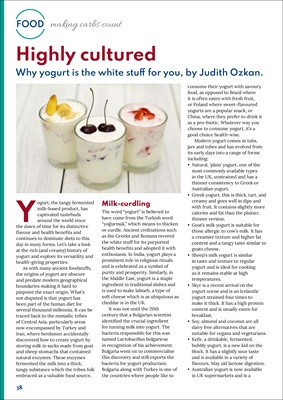
38
FOOD making carbs count
Highly cultured
Why yogurt is the white stuff for you, by Judith Ozkan.
Yogurt, the tangy fermented
milk-based product, has
captivated tastebuds
around the world since
the dawn of time for its distinctive
flavour and health benefits and
continues to dominate diets to this
day in many forms. Let's take a look
at the rich (and creamy) history of
yogurt and explore its versatility and
health-giving properties.
As with many ancient foodstuffs,
the origins of yogurt are obscure
and predate modern geographical
boundaries making it hard to
pinpoint the exact origin. What's
not disputed is that yogurt has
been part of the human diet for
several thousand millennia. It can be
traced back to the nomadic tribes
of Central Asia, particularly areas
now encompassed by Turkey and
Iran, where herdsmen accidentally
discovered how to create yogurt by
storing milk in sacks made from goat
and sheep stomachs that contained
natural enzymes. These enzymes
fermented the milk into a thick,
tangy substance which the tribes folk
embraced as a valuable food source.
Milk-curdling
The word "yogurt" is believed to
have come from the Turkish word
"yoğurmak," which means to thicken
or curdle. Ancient civilizations such
as the Greeks and Romans revered
the white stuff for its purported
health benefits and adopted it with
enthusiasm. In India, yogurt plays a
prominent role in religious rituals
and is celebrated as a symbol of
purity and prosperity. Similarly, in
the Middle East, yogurt is a staple
ingredient in traditional dishes and
is used to make labneh, a type of
soft cheese which is as ubiquitous as
cheddar is in the UK.
It was not until the 20th
century that a Bulgarian scientist
identified the crucial ingredient
for turning milk into yogurt. The
bacteria responsible for this was
named Lactobacillus bulgaricus
in recognition of his achievement.
Bulgaria went on to commercialise
this discovery and still exports the
bacteria for yogurt production.
Bulgaria along with Turkey is one of
the countries where people like to
consume their yogurt with savoury
food, as opposed to Brazil where
it is often eaten with fresh fruit,
or Poland where sweet-flavoured
yogurts are a popular snack, or
China, where they prefer to drink it
as a pro-biotic. Whatever way you
choose to consume yogurt, it's a
good choice health-wise.
Modern yogurt comes in tubs,
jars and tubes and has evolved from
its early days into a range of forms
including:
• Natural, 'plain' yogurt, one of the
most commonly available types
in the UK, unstrained and has a
thinner consistency to Greek or
Australian yogurt.
• Greek yogurt, this is thick, tart, and
creamy and goes well in dips and
with fruit. It contains slightly more
calories and fat than the plainer,
thinner version.
• Goat's milk yogurt is suitable for
those allergic to cow's milk. It has
a creamier texture and higher fat
content and a tangy taste similar to
goats cheese.
• Sheep's milk yogurt is similar
in taste and texture to regular
yogurt and is ideal for cooking
as it remains stable at high
temperatures.
• Skyr is a recent arrival on the
yogurt scene and is an Icelandic
yogurt strained four times to
make it thick. It has a high protein
content and is usually eaten for
breakfast.
• Soy, almond and coconut are all
dairy free alternatives that are
suitable for vegans and vegetarians.
• Kefir, a drinkable, fermented,
bubbly yogurt, is a new kid on the
block. It has a slightly sour taste
and is available in a variety of
flavours. May aid lactose digestion.
• Australian yogurt is now available
in UK supermarkets and is a